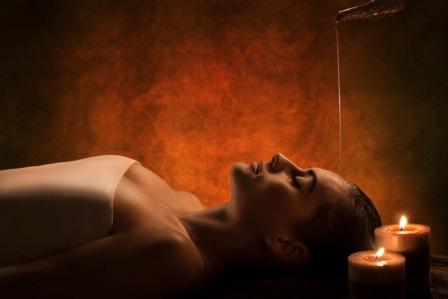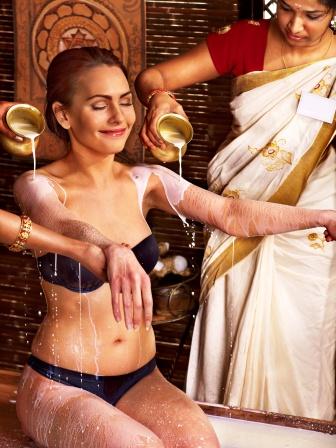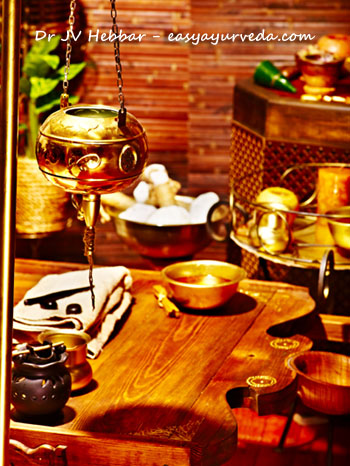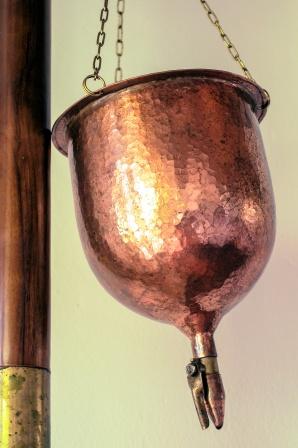Takradhara: Procedure, Methodology, Indication and Benefits
By Dr Raghuram Y.S. MD (Ay).
Takradhara is a traditional Ayurvedic procedure wherein a stream of buttermilk is poured on to the targeted body part. Takradhara is useful in treating psoriasis, hypertension, lack of sleep etc.
What is Takra Dhara?
Thakra Dhara is a word made up of 2 Sanskrit words i.e. Takra and Dhara
- Takra means buttermilk
- Dhara means Pouring in stream
In Takradhara treatment, buttermilk processed with medicinal herbs is used in the form of an external remedy, in the form of a thin stream.
Table of Contents
Benefits of Takra Dhara:
Takra Dhara is highly effective in alleviating the below said disorders –
- Raktagata Vata – Hypertension
- Anidra – Sleeplessness / Insomnia
- Palitya – Premature greying of hairs
- Klama – Tiredness, fatigue
- Shira shoola – Headache
- Dosha kopa – Aggravation of Doshas
- Ojakshaya – Low immunity
- Kara-charana parisphotanam – Cracks and fissures in the hands (palm) and foot (sole)
- Mutradosham – Urinary disorders
- Sandhi shaitilya – Laxity and loss of integrity of joints (fragile joints)
- Hridroga – Heart diseases
- Agnimandhya – Sluggish metabolism
- Aruchi – Tastelessness / Anorexia
- Karna roga – Diseases of the ear
- Netra roga – Diseases of the eye
- Kitibha / Ekakushta – Psoriasis
- Ardhavabhedaka / Suryavarta – Hemicrania / Migraine headache
- Pitta Rogas – Pitta predominant disorders (Diseases caused due to contamination of Pitta)
- Vata Rogas – Vata predominant disorders(Diseases caused due to contamination of Vata)
- Smriti Nasha – Loss of memory / Alzheimer’s disease
- Khalitya – Hair loss and hair fall
- Darunaka – Dandruff
- Madhumeha janya Vataroga (Vataja Prameha) – Diabetic neuropathy
- Pakshaghata – Paralysis
- Avasada – Depression

Types of Thakradara:
- Takra Shiro Dhara – Dhara done over the head of the patient – useful in headache, hypertension, migraine etc.
- Takra Kaya Dhara – Also called Sarvanga Takradhara – Dhara done for the whole body – useful in stress, fatigue.
- Takra Ekanga Dhara – Dhara done over a portion of the body Example. As in case of a limb afflicted with Psoriasis

How is Shiro Takradhara done?
Takra Shirodhara is done in 3 different stages which include:
- Purva Karma (Pre-treatment procedures)
- Patient examination
- Disease examination
- Patient counselling
- Collection of materials
- Preparation of medicine and patient
- Pradhana Karma (Treatment procedure)
- Paschat Karma (Post-treatment procedures / Follow up)
Pre-treatment procedures – Purva Karma of Takra Shiro Dhara
The Pre-treatment procedures of Takra Dhara comprises of the below said steps of operation:
Rogi Pareeksha (Patient examination):
- Thorough examination of the patient is done with
Trividha Pareeksha (3 fold examination of the patient including inspection, palpation and interrogation) and
Ashta Sthana Pareeksha (8 fold examination of the patient including the examination of Pulse, stools, urine, tongue, eye, sound, touch and built). - Panchendriya Pareeksha (Examination of the patient using sense organs) and Dashavidha Pareeksha (10 fold examination of the patient including Prakriti – body type, Vikriti – examination of the ailment etc) can also be included.
Roga Pareeksha (Disease examination and diagnosis):
- It is equally important to know the nature of the disease in detail. Thorough examination of the disease is done through the examination of
Nidana Panchaka (5 factors related to the disease and its knowledge) which includes Nidana (causative factors), Purvarupa (Premonitory symptoms), Rupa (Symptoms of a disease), Upashaya-Anupashaya (Aggravating and relieving factors) and Samprapti (Pathogenesis).

Rogi Samalochana (Patient counselling):
- The patient and the family members shall be detailed about the procedure, the benefits and limitations of the treatment. The patient should be instructed to lend a sincere cooperation in terms of following a strict diet, lifestyle and medicinal protocol (prescription) as and when advised, for the success of the treatment.
Laboratory tests (biological) for urine, blood etc and radiological reports shall be advised to identify and rule out the diseases at the backdrop and also to rule out complications.
The Roga and Rogi Pareeksha would give us a total summary of the disease and the diseased in the form of a documented case Performa.
Dravya Sangraha (Collection of essentials and materials required for the treatment):
Materials and essentials required for the treatment should be collected beforehand
Materials required for Takradara:
- Dhara Droni (Table) – It is a special table designed for conducting the treatment of Dhara. The table is generally made out of oil proof wood so that the oil doesn’t percolate through the wood. This caution is taken because the table is used for multipurpose. Treatments like Taila dhara (medicated oil pouring over the body), Abhyanga (massage using medicated oils) etc are also carried over on the same table apart from Takra Dhara. The table is also called by the name Taila Droni (Taila meaning oil, Droni meaning table).

Parts of the table:
Anterior compartment or head compartment – This is approximately 2 ½ to 3 feet in length and of similar dimension in breadth. It has an elevated portion for head support at the junction of anterior and posterior compartments. On this portion, there is a small depression to accommodate the occipital portion of the head. Just behind this head support the portion of this compartment has a depression into which the fluid falling on the head of the patient flows. The depressed part is continuous with an opening or a draining part which descends downwards. The drain is collected to a collection vessel / pot.
Posterior compartment or body compartment: This portion is a continuity of head compartment and is meant for the patient to lie down (accommodates the body of the patient). It measures roughly between 7 ½ to 8 feet in length and 2 ½ to 3 feet in breadth.
The height of the table is roughly 2 ½ to 3 feet from the ground with an adjustable option.
- The Dhara stand: This is a stand made up of wood or metal and is placed exactly behind the head end of the table. The stand has a hook at the top whose height can be adjusted to varying lengths. The stand is roughly 6 to 7 feet in height with a tripod or circular base.
- The Dhara Pot: This is a vessel usually made up of metal or earthen material. A small hole is made at the bottom of the vessel so as to accommodate a cotton wick or a cloth. A sterile cloth or wick is passed through the hole such that a portion of it lies within the vessel and a couple of inches of its length lie outside the vessel. The portion within the vessel is knotted such that it almost blocks the hole. The idea is that the liquid should drip down slowly through the cloth instead of falling in a big stream through the hole. The vessel is suspended from the stand with the help of the hook such that the wick comes to lie a few inches above the mid part of the forehead of the lying patient.

- The collection pot / vessel: This vessel is placed at the bottom of the drain at the head end of the table. It collects the fluid coming down from the head compartment and the attendant placed for collection keeps refilling the dhara pot in the collection pot. Thus the Takra collected in the collection vessel is recycled until the procedure is completed. When one collection pot is removed another pot is kept in place.
- A stove: To warm the medicine in case the doctor advises the medicament to be kept warm during the treatment procedure.
- Steel vessels: 2 in number for preparation of the medicines needed for dhara.
- Sterile cotton pads and bandage cloth: To pad the patient’s eye during the procedure
- Large Spoons – 2 in number, to mix the medicaments during preparation and subsequently during treatment
- Sterile clothes: For wiping after treatment
- Chair / Stools: For the Doctor / attendants to be seated
- Small Pillow: For neck support
- Man Power: If the doctor himself is conducting the treatment he may need 1 or 2 assistants to help him in the procedure. Even otherwise a minimum of 3 people would be needed to carry on the treatment in an uninterrupted way.
How to prepare Buttermilk for Takradhara:
- Amalaki Churna (Coarse powder of Amla – Emblica officinalis) – 1 ¼ Prastha (80 tola – 960 grams)
Note: Good quality Amalaki (Indian Gooseberry fruit or Emblica officinalis) fruits dried in sunlight and air for at least a period of 1 year. The coarse powder of such Amalaki should be taken. Care should be taken to choose quality fruits devoid of contamination. Seeds should be discarded beforehand.
- Takra (sour buttermilk) – 38 tola quantity (456 grams)
- Jalam: Water – 18 Kudava quantity (228 tola – 2736 grams)
- Rasnadi Churnam for Talam (for application on the crown of the scalp after the treatment)
Preparation of the medicine (medicated buttermilk for dhara):
Method 1:
- The powder of Amalaki and water are taken in the mentioned proportions
- They are heated on moderate fire on the stove until 1/6th of water remains (i.e. until 38 tola – 456 grams)
- The contents are filtered
- To this equal quantity of sour buttermilk – 38 tola (456 grams) is added
- The medicine for Takra Dhara is ready for use
Method 2:
- 40 pala quantity (480 grams) of Amalaki powder is boiled with 9 prastha quantity (576 tola – 6912 grams) of water on a moderate flame until 1 ½ prastha (96 tola – 1152 grams) of it remains.
- To this equal quantity of buttermilk (1152 grams approximately) is added
- The resultant mixture is used for Takra Dharam.
Method 3:
- 2 Prastha quantity (128 tola – 1536 grams approximately) of cow’s milk is mixed with 8 prastha quantity (512 tola – 6144 grams approximately) of water and 2 pala (8 tola – 96 grams approximately) of Musta Churna (powder of Cyperus rotundus) are added.
- The contents are heated on moderate fire until all the water evaporates and only milk is left over.
- After the milk gets cooled, a small quantity of curd is added and the milk is curdled
- To this, Amalaki Kwatha (decoction prepared from coarse powder of amla) is added in a quantity of 1 prastha (64 tola – 768 grams) and churned well so as to prepare buttermilk
- The resultant mixture is used for Takra Dhara
- {Method of preparing Amalaki Kwatha – 4 prastha (3072 grams) of coarse powder of Amalaki is boiled in 4 prastha quantity of water until 1 prastha remains (768 grams). The contents are filtered}
Preparation of the patient:
- The patient is advised to shave his head before hand, for better effect and results of the treatment. However, it is done without shaving the head as well.
- The patient should have undergone a course of Vamana (therapeutic emesis) or Virechana (therapeutic purgation) as per their constitution and pathology (Optional – depends on the decision of the physician to carry out the cleansing procedures beforehand) beforehand as a part of systemic detoxification
Pradhana Karma – Treatment proper, the main procedure of Takra Dhara:
The main procedure will be done as said below
Patient examination on the day of treatment:
- On the day of the treatment vital parameters should be examined viz pulse reading, BP recording, conjunctiva, temperature etc. interrogation regarding the recently developed complaints if any should be done. The treatment shall be suspended or postponed in case of presence of complaints like cold, congestion, weakness or fatigue, fever, jaundice, menstrual periods in women or any other serious complaints or the exacerbation of the same on the day of treatment.
- A treatment protocol should be maintained. Important findings and changes should be noted on a daily basis throughout the length of the treatment procedure.
The main procedure of Takra Dhara shall be carried over after confirming that the patient is absolutely fit to undergo the same.
Abhyanga, Placement of patient, attendants and dhara vessel:
- The patient shall be made to lie on the Dhara table with his head resting on the elevation at the head end. A small pillow is placed as a neck support beneath the neck of the patient. Shiro Abhyanga (Head massage) can be given with Vata alleviating oils like Ksheerabala Taila Massage with medicated oils can be given to the whole body (optional) before Dhara.
- Cotton pads are placed on the eyes of the patient to avoid the medicaments entering the eyes. The pads can also be tied lightly in position around the eyes as an alternative.
- The doctor conducting the treatment or the chief attendant should stand or be seated at the head end. One more attendant should be seated near the collecting vessel.
- The Dhara stand should be placed vertically near the head end
- The Dhara vessel fitted with the cotton wick or sterile cloth in the opening at the bottom should be suspended from the hook with the help of a chain or thick rope such that the wick is at a height of at least 2 feet above the midpoint of the centre of the patient’s forehead
- The Dhara vessel should be filled with the medicine (medicated Takra or buttermilk)
Conducting the procedure of Dhara:
The attendant adjusts the level of Dhara pot / vessel such that the wick / cloth fit to the hole at the bottom of the vessel is a couple of inches above the mid-point of the forehead of the lying patient. The vessel is filled with medicated Takra (buttermilk). The medicine oozes through the wick / cloth and falls on the forehead of the patient in a stream. The attendant keeps swinging the vessel slowly across the patients head so that the Takra falls all over the scalp uniformly. Simultaneously the head is lightly massaged for better effect.
The Takra now goes down the drain and gets collected in the collecting vessel at the bottom of the table. The second attendant removes the collection vessel once it is full and places another empty vessel beneath the connecting drain. He now pours the Takra collected in the vessel back into the Dhara pot. This recycling of Takra is done until the procedure gets finished within the stipulated / prescribed duration.
Height from which the Dhara (stream should fall):
- The liquid used in Dhara (Takra in this context) should fall from a height of at least 4-6 inches. This means to tell that the end of the wick should be at least 4-6 inches above the forehead of the patient
Temperature of Dhara fluid:
- The temperature of Takra shall be cold in Pitta condition and lukewarm in Vata and Kapha association
Note: The Takra (medicated buttermilk) should be prepared on a daily basis and should not be reused.
Duration of Takra Dhara:
- Takra Dhara can be done for a period of 45 minutes to 60 minutes at a stretch (1 sitting) depending on the nature and severity of Hypertension (or other disease for which Dhara is being done) or depending on the constitution of the patient
- Takra Dhara is done for a period of 7 to 14 days or as recommended by the physician. The relief of complaints and betterment in the values of blood pressure is taken as a parameter for fixing and limiting the number of days of treatment to be done at a stretch
- Time of the day: Takra Dhara is usually done in the early hours of the morning (preferably between 6 am and 10am)
Note: In case of Kaya dhara – Takradhara for whole body, the stream of takra is directed to whole part of body uniformly.
In case of Ekanga dhara – Takradaram for targeted body part, the stream of buttermilk is directed to particular body part only, for the specified amount of time.
Cleaning: The patient’s scalp is wiped with a sterile cloth and the body is swabbed with warm sponging.
Paschat Karma of Takra (Shiro) Dhara (Post-treatment procedures and follow up)
Tala Dharana – Rasnadi Churna is applied on the crown of the forehead and rubbed for few seconds. This will combat the cold induced by the treatment procedure. Some people of Vata or Kapha constitution can catch up with cold after the treatment. Alternatively the paste of Rasnadi Churna is applied on the crown of the sclap, a sterile cotton pad placed over it (alternately the leaves of Vata alleviating leaves viz Eranda Patra (Ricinis communis) or Nirgundi Patra (Vitex negundo) etc. are placed over the applied paste) and a bandage cloth is tied around the scalp.
Swedana (Bashpa Swedana) – Fomentation or steam bath with herbal decoction is given on the preference of the physician especially in Hypertension associated with Vata and Kapha symptoms. It is usually done 1 hour after the treatment.
Snana (Bath): If the patient is being treated on IPD basis, warm water bath is advised after a couple of hours after treatment or after Swedana. Water processed with Dashamoola (10 roots), Nirgundi (Vitex negundo), Nimba (Azadirachta indica) etc is used for bathing purpose. Otherwise the patient is advised to take a warm bath at home.
Discharge – The patient is discharged with suitable instructions on a daily basis if the patient is handled as an outpatient. In such cases the patient would visit the clinic or hospital on a daily basis and take the treatment for a scheduled duration. If the patient is taking the treatment as inpatient the patient is finally discharged after the completion of the course.
Diet and lifestyle recommendations:
- Light digestible food is recommended on the days of treatment. The patient is advised not to take stomach full of food. Fried and refrigerated foods and heavy foods are avoided. Hot and fresh food should be taken. Hot water should be used for drinking and bathing purposes.
- Abstinence from excess stress, sex, exposure to sunlight, dust and heavy breeze, smoking, alcohol, withholding natural urges (reflexes) i.e. Vegavarodha, walking for long distances and heavy exercise is advised. The patient should not sleep for long hours and also not remain awakened till late night. The head position (placement of pillow) while sleeping should neither be too high nor too low. Speaking too much and speaking loudly is restricted. The patient should keep away from emotional highs and lows. They should keep away grief and anger. The patient is advised to take a break from the work if possible (during treatment).
- Liquid diet added with ginger, cumin seeds etc should be given. Rice gruel or green gram gruels are very good dietetic inclusions.
- Dhanyaka sidda jala (Water processed with coriander), buttermilk mixed with Trikatu Churna and ghee should be prescribed
Nitya Virechana: Doctor’s prefer giving a mild laxative on a daily basis during the treatment process. This helps to clean the body of its toxins and in keeping the body and mind light and relaxed. Generally Gandharvahastadi Kashayam (medicated decoction with castor plant as the chief ingredient) is given twice daily on empty stomach. 15 ml of Kashayam with 30-45ml of warm water is the ideal dose. It is believed that during Parisheka (synonym of dhara) some cellular toxins (doshas and malas) are released into the gut. They should be evacuated on a regular basis with herbal laxative. If left alone the morbid doshas can cause indigestion, tastelessness, constipation, flatulence, bloating etc and also aggravate the existing disease.
Vyadhihara Ghrita: Alternative,to the daily laxative some doctors prescribe medicated ghee (disease specific) in a low dose (10-25ml) to be taken mixed with hot milk at bedtime. This is preferred in Hypertension patients of Pitta constitution (Vata-Pitta constitution also). These Ghrita’s not only alleviate the disease at the backdrop of hypertension (secondary hypertension) but also provide a laxative effect and help in removing the toxins from the body. They are also beneficial for alleviating hypertension. Ex. Arjuna Ghrita is advised when Hypertension is associated with heart ailments, Trikantakadi Ghrita is preferred when the kidney and urinary system is afflicted in hypertension, Ashwagandhadi Ghrita, Saraswatha Ghrita, Brahmi Ghrita or Shatavari Ghrita is recommended when there is lot of stress associated with hypertension etc.
As a follow up:
- A diet chart and a catalogue / write up of do’s and don’ts (with respect to diet and lifestyle changes) is given
- Prescription of oral medicines to be taken is handed over to the patient
- The date for the next follow up consultation is given
- Takra Dhara is recommended on a regular basis (at least two courses a year or 1 sitting in a month)
Side effects:
- No major side effects have been seen during the treatment of Takra Dhara. The treatment is thus well tolerated.
- There are a few exemptions wherein the patients develop cold and cold related symptoms including chills. In such cases the Taladharana with Rasnadi Churnam should be done with special precaution. If chills develop, the treatment shall be suspended for a short duration and restarted on a later day. There might be an initial reaction to the treatment procedure in the first attempt which is seen to wane down in the successive attempts.
Limitations:
- Takra dhara might just not be the one and the only remedy to tackle Hypertension or the mentioned list of ailments. It may need to be combined with effective medicines (oral), diet and lifestyle changes. It is found to be highly effective in Primary (Essential) Hypertension
- The secondary diseases should be parallel treated with disease specific medications though Takra Dhara is seen to independently combat and give a substantial relief in the diseases at the backdrop also. Like Takra dhara is seen to significantly relieve the heart diseases or diabetes associated with hypertension.
Possible mode of action of Takra Dhara:
The Takra (buttermilk) has hot effect. But the combination of Amalaki, Musta and Takra produces a coolant effect on the brain and the whole nervous system and hence releases the stress and anxiety stagnant in the chief controlling station of our body. As we know that the brain controls all the functions of the body. The master gland Pituitary and the hypothalamus associated with many physical and mental functions are located in the head. When all these are relaxed, the body functions including the heart functions take place in a relaxed manner. The circulation of blood and nutrients take place in a proper way. The peripheral resistance is reduced. The channels of the body open up. The cells start flushing the toxins and overall metabolism gets improved.
Takra Dhara is highly effective in relieving stress. When stress is removed the psychosomatic disorders like psoriasis etc are subjected to an effective healing. Stubborn psoriasi which has not been relieved by any medication responds to Takra Dhara. Here the dhara is not only done for the head but also over the lesions.
Takradhara: Best Gift from Ayurveda for Hypertension (Blood Pressure) Patients
Among many options of treatment and medications available in Ayurveda for the management of Hypertension, Takra Dhara is the best choice.
Thus Takra Dhara is a treatment in which the medicated (processed with herbs, medicines) buttermilk is poured in stream over the target area. forehead and scalp of the patient suffering from Hypertension for a fixed duration of time while the patient lies on his or her back over a specially designed table meant for the treatment.

In hypertension the rakta dhatu or blood element is abruptly handled by the disturbed Vayu. The blood and Pitta have an inseparable relationship as Pitta resides in the blood. When the pitta gets disturbed, the rakta too gets disturbed and vice versa. Takra dhara by the virtue of its coolant effect pacifies the hot, intense and penetrating nature of both pitta and rakta. It also controls Vayu by the virtue of its combination.
Takra Dhara relaxes & revitalises the central nervous system, balances the brain and hormonal functions and thus regularises and relaxes all the functions of the body. The stress in each and every cell and passage of the body is removed. It has a soothing effect on the endocrine system.
Takra Dhara improves the supply of blood and nutrition to the brain
The pressure and temperature effect of the medicament cannot be ruled out
With an Ayurveda perspective Takra Dhara might communicate with the deepest recesses of the brain by soothing the Marmas (vital points of convergence of bones, muscles, blood vessels, soft tissues and joints) located in the head viz Apanga, Avarta, Shanka, Utkshepa, Seemantha and Sthapani Marma’s with which the dhara liquid comes into contact with.
Most of these Marma’s are related to the eye and blood circulation to the brain. By activating the Marma’s Takra Dhara might make a strong impact on the functioning of central nervous system and important glands within the brain.
Alochaka Pitta (Pitta subtype) which is located in the Eye is said to be of 2 types. One is Chakshu Vaisheshika (located within the eye and maintains its well being) and the other is Buddhi Vaisheshika (the part of Alockhaka Pitta which has its connectivity with higher centres of the brain and thus monitors the higher functions like intelligence, memory etc). Apanga and Avarta marma’s are related to the eye. Dhara might make a soothing impact on buddhi vaisheshika alochaka pitta through these Marma’s and in return soothe the nervous system.
The injury of Seemantha Marma (joints of the skull) is said to cause Chitta Nasha (psychological abnormality) and Bhaya (fear complex). Thus when the same Marma is healed through Dhara, it may reverse the Chitta Nasha and Bhaya, i.e. it might relieve stress, anxiety and depression. With this the relaxed nervous system will take care of heart functions and circulation patterns. This in turn will benefit in reversing the events in hypertension.
The soothing of these Marma’s and in turn soothing of Nervous system and endocrine glands as an effect of Takra Dhara will definitely relax Prana Vayu, Sadhaka Pitta and Tarpaka Kapha in the brain (head). These inturn will have a relaxing effect over the Vyana Vayu, Ranjaka Pitta, Avalambaka Kapha and Udana Vayu controlling the heart functions and circulation. The ultimate effect will be a good relief from Hypertension.
Click here to read more about Hypertension and Ayurvedic management
Takra Dhara is the best option for those suffering from Hypertension and its complications. If you haven’t tried, it is worth trying and recommending. But don’t forget to consult an Ayurvedic Doctor beforehand. Any treatment or medicine is dangerous without a Doctor’s prescription or advice.
Click to consult Dr Dr Raghuram Y.S. MD (Ayu), directly, or by skype / email










2 comments
Dr.M.S.Kamath
Please go through the poineer research done by Dr. Ubeba on dhara at Japan
Deepak
Very usefull and informative